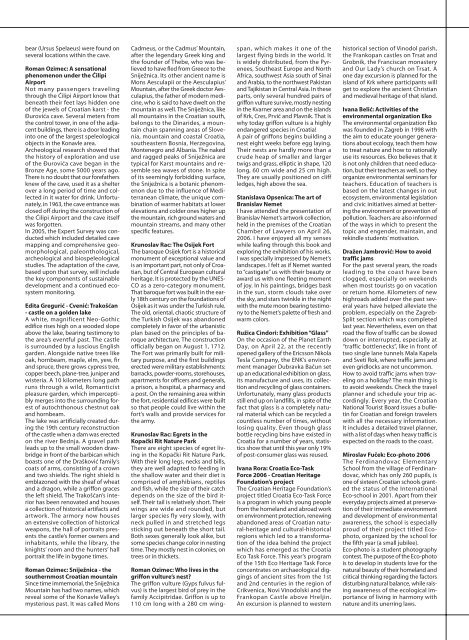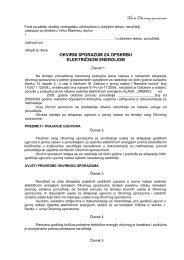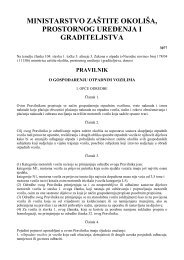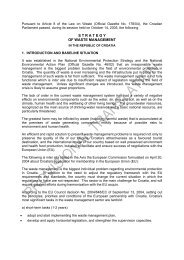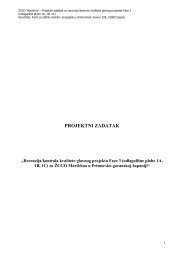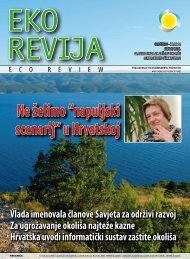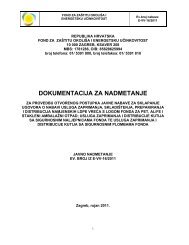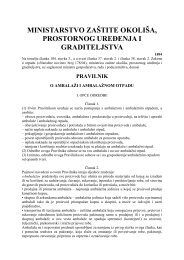Eko revija broj 7 - Fond za zaštitu okoliša i energetsku učinkovitost
Eko revija broj 7 - Fond za zaštitu okoliša i energetsku učinkovitost
Eko revija broj 7 - Fond za zaštitu okoliša i energetsku učinkovitost
Create successful ePaper yourself
Turn your PDF publications into a flip-book with our unique Google optimized e-Paper software.
ear (Ursus Spelaeus) were found on<br />
several locations within the cave.<br />
Roman Ozimec: A sensational<br />
phenomenon under the Ćilipi<br />
Airport<br />
Not many passengers traveling<br />
through the Ćilipi Airport know that<br />
beneath their feet lays hidden one<br />
of the jewels of Croatian karst - the<br />
Đurovića cave. Several meters from<br />
the control tower, in one of the adjacent<br />
buildings, there is a door leading<br />
into one of the largest speleological<br />
objects in the Konavle area.<br />
Archeological research showed that<br />
the history of exploration and use<br />
of the Đurovića cave began in the<br />
Bronze Age, some 5000 years ago.<br />
There is no doubt that our forefathers<br />
knew of the cave, used it as a shelter<br />
over a long period of time and collected<br />
in it water for drink. Unfortunately,<br />
in 1963, the cave entrance was<br />
closed off during the construction of<br />
the Ćilipi Airport and the cave itself<br />
was forgotten.<br />
In 2005, the Expert Survey was conducted<br />
which included detailed cave<br />
mapping and comprehensive geomorphological,<br />
paleonthological,<br />
archeological and biospeleological<br />
studies. The adaptation of the cave,<br />
based upon that survey, will include<br />
the key components of sustainable<br />
development and a continued ecosystem<br />
monitoring.<br />
Edita Gregurić - Cvenić: Trakošćan<br />
- castle on a golden lake<br />
A white, magnificent Neo-Gothic<br />
edifice rises high on a wooded slope<br />
above the lake, bearing testimony to<br />
the area’s eventful past. The castle<br />
is surrounded by a luscious English<br />
garden. Alongside native trees like<br />
oak, hornbeam, maple, elm, yew, fir<br />
and spruce, there grows cypress tree,<br />
copper beech, plane-tree, juniper and<br />
wisteria. A 10 kilometers long path<br />
runs through a wild, Romanticist<br />
pleasure garden, which imperceptibly<br />
merges into the surrounding forest<br />
of autochthonous chestnut oak<br />
and hornbeam.<br />
The lake was artificially created during<br />
the 19th century reconstruction<br />
of the castle when a dam was erected<br />
on the river Bednja. A gravel path<br />
leads up to the small wooden drawbridge<br />
in front of the barbican which<br />
boasts one of the Drašković family’s<br />
coats of arms, consisting of a crown<br />
and two shields. The right shield is<br />
emblazoned with the sheaf of wheat<br />
and a dragon, while a griffon graces<br />
the left shield. The Trakošćan’s interior<br />
has been renovated and houses<br />
a collection of historical artifacts and<br />
artwork. The armory now houses<br />
an extensive collection of historical<br />
weapons, the hall of portraits presents<br />
the castle’s former owners and<br />
inhabitants, while the library, the<br />
knights’ room and the hunters’ hall<br />
portrait the life in bygone times.<br />
Roman Ozimec: Sniježnica - the<br />
southernmost Croatian mountain<br />
Since time immemorial, the Sniježnica<br />
Mountain has had two names, which<br />
reveal some of the Konavle Valley’s<br />
mysterious past. It was called Mons<br />
Cadmeus, or the Cadmus’ Mountain,<br />
after the legendary Greek king and<br />
the founder of Thebe, who was believed<br />
to have fled from Greece to the<br />
Sniježnica. Its other ancient name is<br />
Mons Aesculapii or the Aesculapius’<br />
Mountain, after the Greek doctor Aesculapius,<br />
the father of modern medicine,<br />
who is said to have dwelt on the<br />
mountain as well. The Sniježnica, like<br />
all mountains in the Croatian south,<br />
belongs to the Dinarides, a mountain<br />
chain spanning areas of Slovenia,<br />
mountain and coastal Croatia,<br />
southeastern Bosnia, Herzegovina,<br />
Montenegro and Albania. The naked<br />
and ragged peaks of Sniježnica are<br />
typical for Karst mountains and resemble<br />
sea waves of stone. In spite<br />
of its seemingly forbidding surface,<br />
the Sniježnica is a botanic phenomenon<br />
due to the influence of Mediterranean<br />
climate, the unique combination<br />
of warmer habitats at lower<br />
elevations and colder ones higher up<br />
the mountain, rich ground waters and<br />
mountain streams, and many other<br />
specific features.<br />
Krunoslav Rac: The Osijek Fort<br />
The baroque Osijek fort is a historical<br />
monument of exceptional value and<br />
is an important part, not only of Croatian,<br />
but of Central European cultural<br />
heritage. It is protected by the UNES-<br />
CO as a zero-category monument.<br />
That baroque fort was built in the early<br />
18th century on the foundations of<br />
Osijek as it was under the Turkish rule.<br />
The old, oriental, chaotic structure of<br />
the Turkish Osijek was abandoned<br />
completely in favor of the urbanistic<br />
plan based on the principles of baroque<br />
architecture. The construction<br />
officially began on August 1, 1712.<br />
The Fort was primarily built for military<br />
purpose, and the first buildings<br />
erected were military establishments:<br />
barracks, powder-rooms, storehouses,<br />
apartments for officers and generals,<br />
a prison, a hospital, a pharmacy and<br />
a post. On the remaining area within<br />
the fort, residential edifices were built<br />
so that people could live within the<br />
fort’s walls and provide services for<br />
the army.<br />
Krunoslav Rac: Egrets in the<br />
Kopački Rit Nature Park<br />
There are eight species of egret living<br />
in the Kopački Rit Nature Park.<br />
With their long legs, necks and bills,<br />
they are well adapted to feeding in<br />
the shallow water and their diet is<br />
comprised of amphibians, reptiles<br />
and fish, while the size of their catch<br />
depends on the size of the bird itself.<br />
Their tail is relatively short. Their<br />
wings are wide and rounded, but<br />
larger species fly very slowly, with<br />
neck pulled in and stretched legs<br />
sticking out beneath the short tail.<br />
Both sexes generally look alike, but<br />
some species change color in nesting<br />
time. They mostly nest in colonies, on<br />
trees or in thickets.<br />
Roman Ozimec: Who lives in the<br />
griffon vulture’s nest?<br />
The griffon vulture (Gyps fulvus fulvus)<br />
is the largest bird of prey in the<br />
family Accipitridae. Griffon is up to<br />
110 cm long with a 280 cm wing-<br />
span, which makes it one of the<br />
largest flying birds in the world. It<br />
is widely distributed, from the Pyrenees,<br />
Southeast Europe and North<br />
Africa, southwest Asia south of Sinai<br />
and Arabia, to the northwest Pakistan<br />
and Tajikistan in Central Asia. In these<br />
parts, only several hundred pairs of<br />
griffon vulture survive, mostly nesting<br />
in the Kvarner area and on the islands<br />
of Krk, Cres, Prvić and Plavnik. That is<br />
why today griffon vulture is a highly<br />
endangered species in Croatia!<br />
A pair of griffons begins building a<br />
nest eight weeks before egg laying.<br />
Their nests are hardly more than a<br />
crude heap of smaller and larger<br />
twigs and grass, elliptic in shape, 120<br />
long, 60 cm wide and 25 cm high.<br />
They are usually positioned on cliff<br />
ledges, high above the sea.<br />
Stanislava Opsenica: The art of<br />
Branislav Nemet<br />
I have attended the presentation of<br />
Branislav Nemet’s artwork collection,<br />
held in the premises of the Croatian<br />
Chamber of Lawyers on April 26,<br />
2006. I have enjoyed all my senses<br />
while leafing through this book and<br />
exploring the exhibition of his works.<br />
I was specially impressed by Nemet’s<br />
landscapes. I felt as if Nemet wanted<br />
to “castigate” us with their beauty or<br />
award us with one fleeting moment<br />
of joy. In his paintings, bridges bask<br />
in the sun, storm clouds take over<br />
the sky, and stars twinkle in the night<br />
with the mute moon bearing testimony<br />
to the Nemet’s palette of fresh and<br />
warm colors.<br />
Ružica Cindori: Exhibition “Glass”<br />
On the occasion of the Planet Earth<br />
Day, on April 22, at the recently<br />
opened gallery of the Ericsson Nikola<br />
Tesla Company, the ENK’s environment<br />
manager Dubravka Bačun set<br />
up an educational exhibition on glass,<br />
its manufacture and uses, its collection<br />
and recycling of glass containers.<br />
Unfortunately, many glass products<br />
still end up on landfills, in spite of the<br />
fact that glass is a completely natural<br />
material which can be recycled a<br />
countless number of times, without<br />
losing quality. Even though glass<br />
bottle recycling bins have existed in<br />
Croatia for a number of years, statistics<br />
show that until this year only 19%<br />
of post-consumer glass was reused.<br />
Ivana Rora: Croatia Eco-Task<br />
Force 2006 - Croatian Heritage<br />
Foundation’s project<br />
The Croatian Heritage Foundation’s<br />
project titled Croatia Eco-Task Force<br />
is a program in which young people<br />
from the homeland and abroad work<br />
on environment protection, renewing<br />
abandoned areas of Croatian natural-heritage<br />
and cultural-historical<br />
regions which led to a transformation<br />
of the idea behind the project<br />
which has emerged as the Croatia<br />
Eco Task Force. This year’s program<br />
of the 15th Eco Heritage Task Force<br />
concentrates on archaeological diggings<br />
of ancient sites from the 1st<br />
and 2nd centuries in the region of<br />
Crikvenica, Novi Vinodolski and the<br />
Frankopan Castle above Hreljin.<br />
An excursion is planned to western<br />
historical section of Vinodol parish,<br />
the Frankopan castles on Trsat and<br />
Grobnik, the Franciscan monastery<br />
and Our Lady’s church on Trsat. A<br />
one day excursion is planned for the<br />
island of Krk where participants will<br />
get to explore the ancient Christian<br />
and medieval heritage of that island.<br />
Ivana Belić: Activities of the<br />
environmental organi<strong>za</strong>tion <strong>Eko</strong><br />
The environmental organi<strong>za</strong>tion <strong>Eko</strong><br />
was founded in Zagreb in 1998 with<br />
the aim to educate younger generations<br />
about ecology, teach them how<br />
to treat nature and how to rationally<br />
use its resources. <strong>Eko</strong> believes that it<br />
is not only children that need education,<br />
but their teachers as well, so they<br />
organize environmental seminars for<br />
teachers. Education of teachers is<br />
based on the latest changes in out<br />
ecosystem, environmental legislation<br />
and civic initiatives aimed at bettering<br />
the environment or prevention of<br />
pollution. Teachers are also informed<br />
of the ways in which to present the<br />
topic and engender, maintain, and<br />
rekindle students’ motivation.<br />
Dražen Jambrović: How to avoid<br />
traffic jams<br />
For the past several years, the roads<br />
leading to the coast have been<br />
clogged, especially on weekends<br />
when most tourists go on vacation<br />
or return home. Kilometers of new<br />
highroads added over the past several<br />
years have helped alleviate the<br />
problem, especially on the Zagreb-<br />
Split section which was completed<br />
last year. Nevertheless, even on that<br />
road the flow of traffic can be slowed<br />
down or interrupted, especially at<br />
“traffic bottlenecks”, like in front of<br />
two single lane tunnels Mala Kapela<br />
and Sveti Rok, where traffic jams and<br />
even gridlocks are not uncommon.<br />
How to avoid traffic jams when traveling<br />
on a holiday? The main thing is<br />
to avoid weekends. Check the travel<br />
planner and schedule your trip accordingly.<br />
Every year, the Croatian<br />
National Tourist Board issues a bulletin<br />
for Croatian and foreign travelers<br />
with all the necessary information.<br />
It includes a detailed travel planner,<br />
with a list of days when heavy traffic is<br />
expected on the roads to the coast.<br />
Miroslav Fuček: Eco-photo 2006<br />
The Ferdinandovac Elementary<br />
School from the village of Ferdinandovac,<br />
which has only 260 pupils, is<br />
one of sixteen Croatian schools granted<br />
the status of the International<br />
Eco-school in 2001. Apart from their<br />
everyday projects aimed at preservation<br />
of their immediate environment<br />
and development of environmental<br />
awareness, the school is especially<br />
proud of their project titled Ecophoto,<br />
organized by the school for<br />
the fifth year (a small jubilee).<br />
Eco-photo is a student photography<br />
contest. The purpose of the Eco-photo<br />
is to develop in students love for the<br />
natural beauty of their homeland and<br />
critical thinking regarding the factors<br />
disturbing natural balance, while raising<br />
awareness of the ecological importance<br />
of living in harmony with<br />
nature and its unerring laws.


